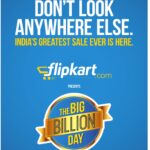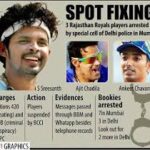Hope of Deliverance: The Silver Lining in the Flipkart Fiasco
The thing with icons and heroes who are put on a pedestal is the inevitability of a fall. Regardless of whether it’s inflicted by fate or brought upon by one’s own deeds it is bound to hurt bad.
There have been Gigabytes of rants in the sociosphere describing how unpleasant the experience was and how suddenly this much loved, revered, more importantly relied upon shopping portal had metamorphosed into a “con” job. Flopkart, Foolkart the brand was getting shot down thick and fast.
Pun apart, the flip side to the story is the fact that over a million (1.5 as per Flipkart’s apology mail) of netizens descended on the site to get their hands on something or anything. Even for a nation that sinks its teeth into the “Yours for Rupee One” formula time and time again the sheer magnitude was a surprise.
The question is if at all any blame needs to be laid on their door? Haven’t there been times when we have turned back from a favourite joint just because it was too crowded or been served bad food or experienced atrocious service? Let’s face it s&^t happens!
I am not passing judgement on Flipkart’s innocence here. No one disputes the fact that the portal could have been better prepared. Last I checked, getting a deal is not anyone’s right. Neither is a communication indicating potential discounts/deals a contract. The point I am trying to make is how can greed be good for one (a customer desirous of a discount) and not the other (a seller aggressively pushing his wares).
Be that as it may, the Flipkart incident is a sign of times and those to come. It’s an emphatic confirmation of the hockey stick trajectory that e-commerce in India is on. A justification perhaps for the billions of dollars of investor faith.
Eighteen: The End of Innocence The top shopping portals are battling it out this festival season in a war reminiscent of the cola wars or the detergent wars. The media houses are raking in the chips. The newspapers are full of gate-folds double spreads, jackets whatever kind of innovation they can offer. Do not have the numbers but would stick my neck out for online guys to have the highest share of voice as compared to any other category.
The white good brands that typically used to surface at this time of the year are seeing their thunder being stolen. It’s a double edged sword for them. On one side the online channel is boosting revenues. On the other, they are holding their breath fearing how the online deals and prices are going to impact their market operating prices, praying it does not give rise to conflict.
While people click and shop away this festive season the online shopping dhamaka’s have given a new hope to all the brands that they host. After two or three failed seasons of the promised festival spike there’s hope of deliverance!
E.Q. -Brands that tugged at your heart
“I’ve learned that people will forget what you said, people will forget what you did, but people will never forget how you made them feel.”
Maya Angelou
This quote has been and continues to be a guiding factor for me as a marketing professional. It can be universally applied to not just to interpersonal situations but to communication as well. If the intent of all brand communication is to create positive impressions that at some point result in a purchase decision in favour of our brands and products then, how it makes one feel on reception is of paramount importance.
 If one were to look at brand messaging and how consumers would “warm up” to the brand there are 4 distinct levels. Communication that talks about the product and its features alone would get the coldest response. The prospects improve to lukewarm once you move from the I to the you and I space where there is talk of benefits. The slightly warmer zones are where brands cater to the status and social needs. The hottest zone is where the brand creates a connect with the consumer at an emotional level.
If one were to look at brand messaging and how consumers would “warm up” to the brand there are 4 distinct levels. Communication that talks about the product and its features alone would get the coldest response. The prospects improve to lukewarm once you move from the I to the you and I space where there is talk of benefits. The slightly warmer zones are where brands cater to the status and social needs. The hottest zone is where the brand creates a connect with the consumer at an emotional level.There are dozens of research papers that define and describe the range of human emotions putting them into positive and negative buckets. Marketers have for long argued whether to go the factual, cut and dry rational way when they communicate or to appeal to & arouse the consumer’s emotions to get them across the line.
 Derrick Daye at the Blake Project in his article 5 Drivers of Brand Insistence says that the ultimate goal of brand equity building is to move the consumer from brand awareness to brand insistence. He opines that there are five elements that drive a consumer to insist upon a particular brand to meet his or her needs – brand awareness, accessibility, value, relevant differentiation, and emotional connection.
Derrick Daye at the Blake Project in his article 5 Drivers of Brand Insistence says that the ultimate goal of brand equity building is to move the consumer from brand awareness to brand insistence. He opines that there are five elements that drive a consumer to insist upon a particular brand to meet his or her needs – brand awareness, accessibility, value, relevant differentiation, and emotional connection.That being said a brand cannot just churn out arbitrary sentimental stuff that has no connect with what they do or offer.
One question that needs to be answered is whether the communication conforms to or breaks the pattern. In a category where emotions are the norm another communication would not break clutter. Also, does the communication provide adequate proof points to the consumer? Remember it’s not enough to get the consumer all mushy, eventually all communication needs to translate into strengthening the brand.
Here’s a compendium of TVCs that caught my eye. They straddle a host of emotions and categories. Interesting to note how many of these brands are leaders in their categories. Some of them go beyond emotion and deliver a strong brand message whilst others definitely touch your heart yet fail to do much else.
[youtube=http://www.youtube.com/watch?v=HkuKHwetV6Q&list=PLdEKkPjjrZSfQD04FfQWvBnzMTb7DjfzM]
To leave your thoughts use the voting buttons J
[polldaddy poll=8210912]
Building Brands Brick by Brick…Literally!
 I was tuned into one of the local FM stations in Delhi as I was driving this morning and I encountered a virtual traffic jam. I changed at least three FM stations trying to catch a song and ran into the radio spots of popular developers in the Delhi NCR. Which is what set me thinking.
I was tuned into one of the local FM stations in Delhi as I was driving this morning and I encountered a virtual traffic jam. I changed at least three FM stations trying to catch a song and ran into the radio spots of popular developers in the Delhi NCR. Which is what set me thinking.We (at least those of us living in the top eight metros) are surrounded today by communication/messages from Real Estate as an industry. Be it television, print, radio, digital or outdoor they are everywhere. According to a recent report 22% of the AdEx comes the real estate industry Given that the you and me of the world are their TG and we seem to be getting exposed to all this communication someone somewhere must be doing their job right. Or is it?
What really is getting communicated to me is that there are lots of choices if I really were to buy property in and around Delhi. The choices indeed span taste and size of pocket. Which at most basis the textbook stages of building brand equity would fall in the awareness category. Push comes to shove, one might even be able to mention the names of a few builders (some brand managers would feel happy ticking of their ToM targets) hence there is some amount of brand recognition that the communication is delivering. Now comes the tricky part. The part that deals with creating a preference for the brand and then extending it into loyalty. Textbook!
Luxury The question in my mind though is whether this cookie-cutter approach works for brands in the real estate space? What really goes into building a brand in the real estate space? What role does the brand have to play in the process/decision of purchase?
For the sake of this discussion we shall look at those who set out to buy with the intention of inhabiting it or at best are looking for a secure investment. For the middle class, buying a house is not a simple decision. Unlike most other purchase decisions brands are not competing with other brands. They are competing with the process of purchase itself. If we were to take a look at what is competition for the brands whilst vying for consumer attention, the list would be long and for anyone who has gone through it, tiring. Starting from the point of realization i.e. “Yes! I/we need to buy a house” through the journey of information seeking, comparison, evaluation etc. the brand of the product which in this case is the house comes in very late into the equation. After going through the usual Where, What, When, How Big, How Much, What else do I get rigmarole the brand often is incidental.
So is there no point building brands in real estate? No, that is neither the import nor the message. The point is brand managers and agencies involved do not seem to be creating communication that is built on a complete understanding of the role of the brand. Most communication is dimensioned on price or the location or the amenities provided etc.
[youtube=http://www.youtube.com/watch?v=P3dzbW35_cM]
Brands in the real estate are in my opinion, built on one of the fundamental gauges of brand strength, trust. Here is a category where the past performance and future promise hold equal importance. The future is aspiration while the past is assurance. Every project that is completed is living testimony to how the brand fared on its time, cost and quality commitments. Every brick that gets laid is literally building the brand. Some of the better brands do talk about this but it usually is a passing mention and easy to miss.
For a sector that is the 2nd highest spender on media/advertising there was not a single real estate brand in the Top 100 of the Brand Equity Most Trusted Brands in India. In fact basis another report the first real estate brand appears at 516 in a list of Top 1200 brands! Of the ones that do appear, not all are into housing.
It is in building and communicating trust that real estate brands need to invest. Basis evidence they sure have a long way to go. Or should I say several floors to the top!
Indian Pigheaded League: When Brands become Stubborn
 As I write this post, the IPL 7 auctions are underway. The PR machinery of the franchise is working overtime to get people enthused and excited. From conversations around which player in which franchise to new kids on the block the twitter universe is abuzz.
As I write this post, the IPL 7 auctions are underway. The PR machinery of the franchise is working overtime to get people enthused and excited. From conversations around which player in which franchise to new kids on the block the twitter universe is abuzz.There is no denying the fact that IPL perhaps has been one of the most popular leagues anywhere in the world. Cricketers of all cricket playing nations with or without test status would give an arm and leg to feature in the league and earn themselves a contract. A lot has been written about how the younger lot of cricketers yearn a chance to play the IPL over donning the national cap!
Someone once said that any publicity is good publicity. Brand IPL seems to live, breathe and propagate this credo. Seldom has a brand been so synonymous with controversies. One might opine that controversy is a design element of the product that IPL is.
What is surprising is that even aspersions on the quality of the core product viz T20 cricket have not come in the way. From match fixing to betting, physical assaults to sexual assaults the IPL seasons have witnessed a range of controversies.
Slapgate The Brawl Molestation Corruption Spot Fixing The Inquiry Good or bad, right or wrong. Let’s face it IPL is a commercial enterprise. A vehicle for other brands to be seen and heard. The designed for Television IPL has seen a declining trend over the past 6 seasons as far its TV ratings are concerned, they are none the less significant. The season six had almost Rs.800Crs riding on it as advertising revenues. That seems to be brand IPL’s reason for chugging along as well. It is for all practical purposes the Super Bowl equivalent of India. Brands plan for their IPL related spends and campaigns much in advance. Those who are not associated or cannot afford the IPL keep their plans ready for reaching consumers outside of the IPL juggernaut during the 45 day spectacle.
A recent report put IPLs brand value in excess of $3Bn with a combined brand valuation of the franchises at over $400Mn. With the depleting central pool and the allied sponsorship/merchandising revenues, the question mark over the franchisees making money however continues. The brand valuations of the individual franchises seems to be the redeeming factor for the investors at the moment.
IPL 6 despite the fixing controversy still beamed into a whopping 129Mn households in India. Might perhaps is right. The might of brand IPL seems to be in its popularity or the numbers. Maybe Indians are so used to the typical masala pot-boiler entertainment format that they have made an allowance for all the negatives in the IPL format.
The question that is begging to be asked is whether brands can truly benefit from an association with a “property” that is so mired in the long run? Is there such a thing as a negative rub-off? After all, media planners and agencies do sell the positive rub-off from an association with integrated properties. Does the end really justify the means?
I guess the Indian consumer is an innocent forgiving lot. More often than not, they judge you for who you are and not who you are seen or associated with. That’s our culture perhaps, our mythology treats a Karna and Vibhishana with respect despite their association with evil.
We are accepting of the multiple shades of grey.
Meanwhile, IPL the brand and the brands that ride on it march on stubbornly into Season 7.
Jai Ho! Re-cycling Brand India
 There’s something about nation and pride. You just need to light the spark and the forest fire will follow. There have been dozens of campaigns across the globe that have relied on stirring patriotism as an emotion. With no numbers to back me up at all I would venture out and say that Hollywood as an entity panders to it the most. I am pretty sure that I am not the only one who has wondered why a certain country is the choicest destination regardless of whether it’s an alien attack or a natural calamity. Just to set the context this is not a review of the Bollywood release either.
There’s something about nation and pride. You just need to light the spark and the forest fire will follow. There have been dozens of campaigns across the globe that have relied on stirring patriotism as an emotion. With no numbers to back me up at all I would venture out and say that Hollywood as an entity panders to it the most. I am pretty sure that I am not the only one who has wondered why a certain country is the choicest destination regardless of whether it’s an alien attack or a natural calamity. Just to set the context this is not a review of the Bollywood release either.Coming back, this post is more to talk about two specific campaigns. 2014 is the year of general elections in India. Media, paid and earned has been flush for little over a year with a government sponsored campaign. Bold, considering the fact that a similar campaign in 2004 allegedly alienated the larger populace from a government that according to the poll pundits was all set to comeback.
The campaigns in question “Bharat Uday” or the India Shining campaign as it was called and the current “Bharat Nirman”. There were several films that were made for both campaigns I am showcasing two that will help make my point.
[youtube=http://www.youtube.com/watch?v=voXU8f3ZUhc]
[youtube=http://www.youtube.com/watch?v=G-x41Fubq-I]
Have lessons been learnt from the past? Well the answer is yes if you think about whether communication pegs have been changed. The earlier 2004 campaign was considered “urban/middle class” in its approach, the current one attempts to be more inclusive (the politically correct word for populist).
Any brand communication should have its bearing right as far as its relevance to the consumer and the competitive context are concerned. An ill-timed or ill-directed communication can do more damage than good that could possibly come out of a campaign.
Either way, millions of dollars get spent in conceiving, producing and airing these campaigns. Many would argue that it is money that could well be spent for several deserving causes. This brings me to the question that I want to ask as a marketer.
“Does show-casing the effect by default communicate the cause?”
This is where I believe the communication has not really shifted or changed. Both the campaigns tried to stake claim to the progress India was making as a nation. Both have tried to piggy ride Brand India.
Political brands need to be marketed akin to services and not as products. To put it at a very basic level, I could probably get away selling toothpaste showcasing shiny teeth but could I really sell a burger saying it shall rid you of hunger?
In a country where the have-nots outnumber the haves, wanting to use Brand India as a surrogate is always going to be a knife that cuts both ways.
It perhaps is not prudent to weave tales that showcase your neighbour’s prosperity. In this country it’s not my relative, it’s not my friend it’s about me. If I have not “experienced” it then it is not true. The mood and sentiment is best communicated by a song from a recent release.
[youtube=http://www.youtube.com/watch?v=0UoEIPwPbm4]
So as much as you want to be seen as the “do-gooder” with every communication that you put out, there is perhaps a larger set that attributes their lack of progress to you.
Problem is in a democracy, majority continues to count!
Happy Republic Day!!
A Lot Like Love: Branding Your Way to your Consumers Wallet
The best way to a Consumers Wallet..is through his heart!

As marketers creating products and communication our biggest challenge is to resist an overload of the rational. Facts and figures as tempting as they seem seldom cut through. Moreover,in todays information age facts are available at the click of a button. So do we really need to be giving more?
Ideally, a brand-consumer interaction should evoke a positive emotion that gets nurtured over time facilitating decisions made by the consumer in favour of the brand. Most agencies argue in favour of an emotional communication and the brand managers are invariably guilty of pushing more fact than necessary. After all, powerful emotions need a powerful loop back to reality. Wrong!
It is true that emotions are invariably in response to a stimulus and that the extent or depth of consumer reaction is a function of the relevance. Brands attempt closure by communicating why the product is relevant to the consumer. We all know brands are built over several campaigns. While the consumer is not out there connecting the dots, there is a residual impact that is lasting which is where emotions come in. A rational journey almost always requires a brushing up on the other hand we can restart an emotional journey after a pause,no matter how long!
Often, the obvious is so close to us that it escapes notice. Having set an emotional context,I guess the mistake that we make is that instead of building on the relevance of the emotion to consumer we bring in the product features.
One may argue that there’s only that much that can be achieved within 30seconds or 45 or 60 whatever the edit length is. Well, yes and no. Yes, there is a limited timeframe to pack in everything. No, it is not just a TV spot that serves as our communication, we live our life in a continuum, there are other avenues available to build the bridge from the emotional to the rational and from thereon to purchase. I have talked about this in a previous post http://abrandviewstory.wordpress.com/2013/12/27/somewhere-over-the-rainbow-principles-for-finding-the-pot-of-gold-in-a-digital-world/ even outside the digital world money spent on a “build” is better than a “repeat”.
As a consumer, if the emotion that you evoked was powerful enough, I will try to find out more, I will find that bridge between the emotional and the rational.
Time and effort are better spent sharpening the emotional side of the communication leading upto why that emotion is relevant to the consumer.The greatest dis-service a brand can do itself is to evoke that emotion and leave it un-nurtured. You might as well spend money on your competitors campaign!
So as a brand or as a product communicating in the emotional plane, I should have answers to the following questions which are indicative not exhaustive:
1) The Promise: What am I going to make you feel? Joyous, triumphant, wanted etc.
2) The Method: How am I going to do it? I am a tool, pride of ownership etc.
3) The Reason: Why should you believe me? Endorsement, Trust etc.
4) The Provocation: Why now is the best time? Opportunity, urgency of need, etc
5) The Exclusivity: Why nobody else will do the way I do? Understanding you, knowing you etcA lot like love isn’t it?
And as food for further thought here’s a recent communication that caught my eye, how many of the above boxes do you think it would tick?
http://www.youtube.com/watch?v=R_UKea_y_dc&list=TL4ekK7bBB2W62RhS_eUfMTFOyzBONMfs0
















